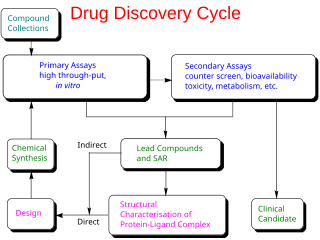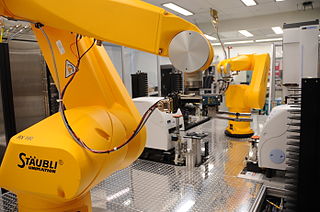Related Research Articles

In vitro studies are performed with microorganisms, cells, or biological molecules outside their normal biological context. Colloquially called "test-tube experiments", these studies in biology and its subdisciplines are traditionally done in labware such as test tubes, flasks, Petri dishes, and microtiter plates. Studies conducted using components of an organism that have been isolated from their usual biological surroundings permit a more detailed or more convenient analysis than can be done with whole organisms; however, results obtained from in vitro experiments may not fully or accurately predict the effects on a whole organism. In contrast to in vitro experiments, in vivo studies are those conducted in living organisms, including humans, known as clinical trials, and whole plants.

Pharmacology is the science of drugs and medications, including a substance's origin, composition, pharmacokinetics, pharmacodynamics, therapeutic use, and toxicology. More specifically, it is the study of the interactions that occur between a living organism and chemicals that affect normal or abnormal biochemical function. If substances have medicinal properties, they are considered pharmaceuticals.
In molecular biology and pharmacology, a small molecule or micromolecule is a low molecular weight organic compound that may regulate a biological process, with a size on the order of 1 nm. Many drugs are small molecules; the terms are equivalent in the literature. Larger structures such as nucleic acids and proteins, and many polysaccharides are not small molecules, although their constituent monomers are often considered small molecules. Small molecules may be used as research tools to probe biological function as well as leads in the development of new therapeutic agents. Some can inhibit a specific function of a protein or disrupt protein–protein interactions.

In the fields of medicine, biotechnology, and pharmacology, drug discovery is the process by which new candidate medications are discovered.

Drug design, often referred to as rational drug design or simply rational design, is the inventive process of finding new medications based on the knowledge of a biological target. The drug is most commonly an organic small molecule that activates or inhibits the function of a biomolecule such as a protein, which in turn results in a therapeutic benefit to the patient. In the most basic sense, drug design involves the design of molecules that are complementary in shape and charge to the biomolecular target with which they interact and therefore will bind to it. Drug design frequently but not necessarily relies on computer modeling techniques. This type of modeling is sometimes referred to as computer-aided drug design. Finally, drug design that relies on the knowledge of the three-dimensional structure of the biomolecular target is known as structure-based drug design. In addition to small molecules, biopharmaceuticals including peptides and especially therapeutic antibodies are an increasingly important class of drugs and computational methods for improving the affinity, selectivity, and stability of these protein-based therapeutics have also been developed.

Medicinal or pharmaceutical chemistry is a scientific discipline at the intersection of chemistry and pharmacy involved with designing and developing pharmaceutical drugs. Medicinal chemistry involves the identification, synthesis and development of new chemical entities suitable for therapeutic use. It also includes the study of existing drugs, their biological properties, and their quantitative structure-activity relationships (QSAR).
A biological target is anything within a living organism to which some other entity is directed and/or binds, resulting in a change in its behavior or function. Examples of common classes of biological targets are proteins and nucleic acids. The definition is context-dependent, and can refer to the biological target of a pharmacologically active drug compound, the receptor target of a hormone, or some other target of an external stimulus. Biological targets are most commonly proteins such as enzymes, ion channels, and receptors.

In pharmacology, the term mechanism of action (MOA) refers to the specific biochemical interaction through which a drug substance produces its pharmacological effect. A mechanism of action usually includes mention of the specific molecular targets to which the drug binds, such as an enzyme or receptor. Receptor sites have specific affinities for drugs based on the chemical structure of the drug, as well as the specific action that occurs there.

Chemogenomics, or chemical genomics, is the systematic screening of targeted chemical libraries of small molecules against individual drug target families with the ultimate goal of identification of novel drugs and drug targets. Typically some members of a target library have been well characterized where both the function has been determined and compounds that modulate the function of those targets have been identified. Other members of the target family may have unknown function with no known ligands and hence are classified as orphan receptors. By identifying screening hits that modulate the activity of the less well characterized members of the target family, the function of these novel targets can be elucidated. Furthermore, the hits for these targets can be used as a starting point for drug discovery. The completion of the human genome project has provided an abundance of potential targets for therapeutic intervention. Chemogenomics strives to study the intersection of all possible drugs on all of these potential targets.
High-content screening (HCS), also known as high-content analysis (HCA) or cellomics, is a method that is used in biological research and drug discovery to identify substances such as small molecules, peptides, or RNAi that alter the phenotype of a cell in a desired manner. Hence high content screening is a type of phenotypic screen conducted in cells involving the analysis of whole cells or components of cells with simultaneous readout of several parameters. HCS is related to high-throughput screening (HTS), in which thousands of compounds are tested in parallel for their activity in one or more biological assays, but involves assays of more complex cellular phenotypes as outputs. Phenotypic changes may include increases or decreases in the production of cellular products such as proteins and/or changes in the morphology of the cell. Hence HCA typically involves automated microscopy and image analysis. Unlike high-content analysis, high-content screening implies a level of throughput which is why the term "screening" differentiates HCS from HCA, which may be high in content but low in throughput.
Drug repositioning involves the investigation of existing drugs for new therapeutic purposes.
Proteostasis is the dynamic regulation of a balanced, functional proteome. The proteostasis network includes competing and integrated biological pathways within cells that control the biogenesis, folding, trafficking, and degradation of proteins present within and outside the cell. Loss of proteostasis is central to understanding the cause of diseases associated with excessive protein misfolding and degradation leading to loss-of-function phenotypes, as well as aggregation-associated degenerative disorders. Therapeutic restoration of proteostasis may treat or resolve these pathologies.
Druggability is a term used in drug discovery to describe a biological target that is known to or is predicted to bind with high affinity to a drug. Furthermore, by definition, the binding of the drug to a druggable target must alter the function of the target with a therapeutic benefit to the patient. The concept of druggability is most often restricted to small molecules but also has been extended to include biologic medical products such as therapeutic monoclonal antibodies.

In the field of drug discovery, reverse pharmacology also known as target-based drug discovery (TDD), a hypothesis is first made that modulation of the activity of a specific protein target thought to be disease modifying will have beneficial therapeutic effects. Screening of chemical libraries of small molecules is then used to identify compounds that bind with high affinity to the target. The hits from these screens are then used as starting points for drug discovery. This method became popular after the sequencing of the human genome which allowed rapid cloning and synthesis of large quantities of purified proteins. This method is the most widely used in drug discovery today. Differently than the classical (forward) pharmacology, with the reverse pharmacology approach in vivo efficacy of identified active (lead) compounds is usually performed in the final drug discovery stages.
Chemical genetics is the investigation of the function of proteins and signal transduction pathways in cells by the screening of chemical libraries of small molecules. Chemical genetics is analogous to classical genetic screen where random mutations are introduced in organisms, the phenotype of these mutants is observed, and finally the specific gene mutation (genotype) that produced that phenotype is identified. In chemical genetics, the phenotype is disturbed not by introduction of mutations, but by exposure to small molecule tool compounds. Phenotypic screening of chemical libraries is used to identify drug targets or to validate those targets in experimental models of disease. Recent applications of this topic have been implicated in signal transduction, which may play a role in discovering new cancer treatments. Chemical genetics can serve as a unifying study between chemistry and biology. The approach was first proposed by Tim Mitchison in 1994 in an opinion piece in the journal Chemistry & Biology entitled "Towards a pharmacological genetics".

In the field of drug discovery, classical pharmacology, also known as forward pharmacology, or phenotypic drug discovery (PDD), relies on phenotypic screening of chemical libraries of synthetic small molecules, natural products or extracts to identify substances that have a desirable therapeutic effect. Using the techniques of medicinal chemistry, the potency, selectivity, and other properties of these screening hits are optimized to produce candidate drugs.

Persomics is a private life science company specializing in genetic research, with locations in Boston, MA, Cupertino, CA, and Gothenburg, Sweden. The company’s aim is to simplify and expedite the process of discovering the basis of disease, and it has established a particular phenotypic screening kit that it uses for this purpose. These kits facilitate the interrogation of thousands of genes in parallel, and therefore pertain to human genome, pharmaceutical and disease model research.
Chemoproteomics entails a broad array of techniques used to identify and interrogate protein-small molecule interactions. Chemoproteomics complements phenotypic drug discovery, a paradigm that aims to discover lead compounds on the basis of alleviating a disease phenotype, as opposed to target-based drug discovery, in which lead compounds are designed to interact with predetermined disease-driving biological targets. As phenotypic drug discovery assays do not provide confirmation of a compound's mechanism of action, chemoproteomics provides valuable follow-up strategies to narrow down potential targets and eventually validate a molecule's mechanism of action. Chemoproteomics also attempts to address the inherent challenge of drug promiscuity in small molecule drug discovery by analyzing protein-small molecule interactions on a proteome-wide scale. A major goal of chemoproteomics is to characterize the interactome of drug candidates to gain insight into mechanisms of off-target toxicity and polypharmacology.
Molecular phenotyping describes the technique of quantifying pathway reporter genes, i.e. pre-selected genes that are modulated specifically by metabolic and signaling pathways, in order to infer activity of these pathways.
RNA-targeting small molecules represent a class of small molecules, organic compounds with traditional drug properties that can bind to RNA secondary or tertiary structures and alter translation patterns, localization, and degradation.
References
- 1 2 Kotz J (April 2012). "Phenotypic screening, take two". Science-Business EXchange. 5 (15): 380. doi: 10.1038/scibx.2012.380 .
- ↑ Wilkinson IV, Terstappen GC, Russell AJ (September 2020). "Combining experimental strategies for successful target deconvolution". Drug Discovery Today. 25 (11): 1998–2005. doi:10.1016/j.drudis.2020.09.016. PMID 32971235. S2CID 221914342.
- ↑ Moellering RE, Cravatt BF (January 2012). "How chemoproteomics can enable drug discovery and development". Chemistry & Biology. 19 (1): 11–22. doi:10.1016/j.chembiol.2012.01.001. PMC 3312051 . PMID 22284350.
- 1 2 Vincent F, Nueda A, Lee J, Schenone M, Prunotto M, Mercola M (May 2022). "Phenotypic drug discovery: recent successes, lessons learned and new directions". Nature Reviews. Drug Discovery. doi:10.1038/s41573-022-00472-w. PMC 9708951 . PMID 35637317. S2CID 249201045.
- ↑ Lee JA, Uhlik MT, Moxham CM, Tomandl D, Sall DJ (May 2012). "Modern phenotypic drug discovery is a viable, neoclassic pharma strategy". Journal of Medicinal Chemistry. 55 (10): 4527–4538. doi:10.1021/jm201649s. PMID 22409666.
- 1 2 3 Swinney DC, Anthony J (June 2011). "How were new medicines discovered?". Nature Reviews. Drug Discovery. 10 (7): 507–519. doi:10.1038/nrd3480. PMID 21701501. S2CID 19171881.
- ↑ Zheng W, Thorne N, McKew JC (November 2013). "Phenotypic screens as a renewed approach for drug discovery". Drug Discovery Today. 18 (21–22): 1067–1073. doi:10.1016/j.drudis.2013.07.001. PMC 4531371 . PMID 23850704.
- ↑ Brown DG, Wobst HJ (March 2020). "Opportunities and Challenges in Phenotypic Screening for Neurodegenerative Disease Research". Journal of Medicinal Chemistry. 63 (5): 1823–1840. doi:10.1021/acs.jmedchem.9b00797. PMID 31268707. S2CID 195798523.
- ↑ Haney SA, ed. (2008). High content screening: science, techniques and applications. New York: Wiley-Interscience. ISBN 978-0-470-03999-1.
- ↑ Giuliano KA, Haskins JR, ed. (2010). High Content Screening: A Powerful Approach to Systems Cell Biology and Drug Discovery. Totowa, NJ: Humana Press. ISBN 978-1-61737-746-4.
- ↑ Willis C, Nyffeler J, Harrill J (August 2020). "Phenotypic Profiling of Reference Chemicals across Biologically Diverse Cell Types Using the Cell Painting Assay". SLAS Discovery. 25 (7): 755–769. doi: 10.1177/2472555220928004 . PMC 9710725 . PMID 32546035. S2CID 219726081.
- 1 2 Barrett MJ, Frail DE, ed. (2012). "PhenotypicIn VivoScreening to Identify New, Unpredicted Indications for Existing Drugs and Drug Candidates". Drug repositioning: Bringing new life to shelved assets and existing drugs. Hoboken, NJ: John Wiley & Sons. pp. 253–290. doi:10.1002/9781118274408.ch9. ISBN 978-0-470-87827-9.
- ↑ Wheeler GN, Tomlinson RA (2012). Phenotypic screens with model organisms. New York, NY: Cambridge University Press. ISBN 978-0521889483.
- ↑ Hellerstein MK (April 2008). "Exploiting complexity and the robustness of network architecture for drug discovery". The Journal of Pharmacology and Experimental Therapeutics. 325 (1): 1–9. doi:10.1124/jpet.107.131276. PMID 18202293. S2CID 36819512.
- ↑ Hellerstein MK (January 2008). "A critique of the molecular target-based drug discovery paradigm based on principles of metabolic control: advantages of pathway-based discovery". Metabolic Engineering. 10 (1): 1–9. doi:10.1016/j.ymben.2007.09.003. PMID 17962055.
- ↑ Saporito MS, Reaume AG (2011). "theraTRACE®: A mechanism unbiased in vivo platform for phenotypic screening and drug repositioning". Drug Discovery Today: Therapeutic Strategies. 8 (2): 89–95. doi:10.1016/j.ddstr.2011.06.002.
- ↑ "Melior Discovery website".
- ↑ "Therapeutic Drug Repurposing, Repositioning and Rescue Part II: Business Review". Drug Discovery World. 6 April 2015. Retrieved 1 May 2015.
- ↑ "Open Innovation Drug Discovery - What are PD2 and TargetD2?". Eli Lilly & Company. Archived from the original on 2012-01-30. Retrieved 2012-06-04.